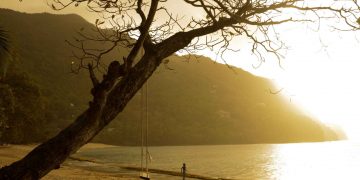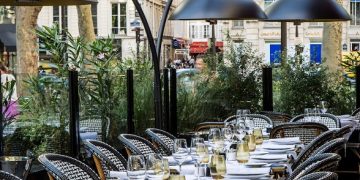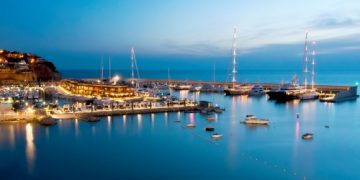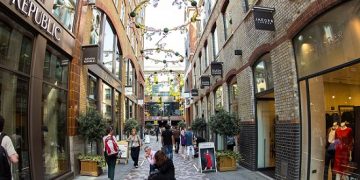Amalfi’s origins dates back to Romans wars against barbaric populations. Legend has it that it was Hercules, son of Jupiter, who conquered Amalfi in order to give it as a present to a girl with beautiful blue eyes the same colour as the sea. The sea and its geographical position, has had a very positive impact on the economic activities of Amalfi. Tourists from all over the world come to a visit the Cathedral, walk in the alleys of the town where you can find interesting workshops or to enjoy the local gastronomy.
Ravello on Amalfi
Ravello is one of the most attractive destinations on the Amalfi Coast. With a population of around 2,000, the settlement perches high above Amalfi, overlooking the Mediterranean. A renowned musical festival is held in Ravello every year, with classical music concerts taking place in gardens with breathtaking views, all through the summer months.
There is also the dreamlike setting of Ravello’s gardens inspired by Wagner, a major feature of Ravello. The Ravello Concert Society organises a long season of chamber music concerts (March-November), most of which are held against a backdrop of sky and sea in the panoramic gardens of Wagner’s inspiration for Parsifal, the Villa Rufolo. Tickets can be bought online from the Society’s website. The combination of scenery and music creates an atmosphere that you’re unlikely to forget.
How to travel to Ravello from Amalfi
Buses run uphill from Amalfi to Ravello. For more information about travelling to the Amalfi Coast, visit the Amalfi Coast page. If you’re driving along the famously nerve-wracking Amalfi Coast roads, bear in mind that the winding roads can get congested, and parking in Ravello can be a challenge. Ravello is high above Amalfi, so only attempt it by foot if you’re feeling fit; Walking back down into Amalfi is easier by following pleasant footpaths through cultivated agricultural terraces and then along the sea-front. I wouldn’t advise attempting this in really hot weather.
Capri
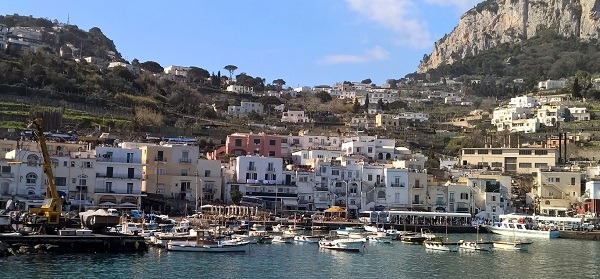
While in Amalfi, you must not fail to visit Capri, an island located in the Tyrrhenian Sea off the Sorrentine Peninsula, on the south side of the Gulf of Naples in the Campania region of Italy. Capri has been a resort since the Roman Republic. It has two harbours, Marina Piccola (the little harbour) and Marina Grande (the main port of the island). The separate comune of Anacapri is located high on the hills to the west.
Travelling to Capri from Amalfi:
Hotel Santa Caterina has a shuttle that can take you to the pier to catch the ferry to Capri. It’s impossible to see all of Capri’s attractions in just one day; but by heading to Capri early, you will have a chance to see many of the island’s best offerings. Take the first ferry for Capri, usually at about 9:30am, which gets you into Capri by 10:30am. Although you can purchase tickets the morning you leave, we’d recommend booking a few days ahead to avoid disappointment—especially in the crowded summer months.
Some of the main features of the island include the Belvedere of Tragara (a high panoramic promenade lined with villas), the limestone crags called sea stacks that project above the sea (the Faraglioni), the town of Anacapri, the Blue Grotto (Grotta Azzurra), and the ruins of the Imperial Roman villas.
The Blue Grotto is one of several sea caves, worldwide, flooded with a brilliant blue or emerald light and was apparently used by Emperor Tiberius during the years when he retired to Capri. Sunlight, passing through an underwater cavity and shining through the seawater, creates a blue reflection that illuminates the cavern. The cave extends some 50 metres into the cliff at the surface, and is about 150 metres deep, with a sandy bottom.
Almost all the tourist boats at the Marina Grande offer an island tour with a whistle stop at the Blue Grotto. To enter the cave you need to change boats into a small one and pay an additional fee. There is usually a long queue for this.
There is also the Green Grotto (photo below), once known as the Grotto dell’ Orefice. The Green Grotto owes its present name to the emerald tones that, at certain times of the day, depending on the light, color its waters.
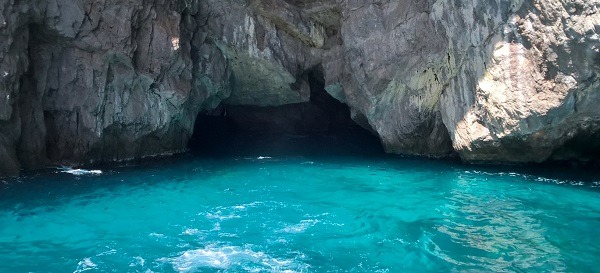
The island tour includes a passage through the Faraglione di Mezzo (photo below) which is characterized by a central cavity, large enough to allow for the passage of a small boat. Guides reckon that cruising through the arch of the Faraglioni whilst kissing your lover – with your eyes closed – gives you eternal love and happiness! The extraordinary rock formations, called the Faraglioni, are truly a magnificent sight!

Remember that the last ferries usually leave for Positano and Amalfi between 4:30pm and 7pm (depending on each provider), giving you a good 6 hours to explore the island.
Note: If you are traveling off-peak, from September to May, contact the Capri tourism office, as ferries will be less frequent.
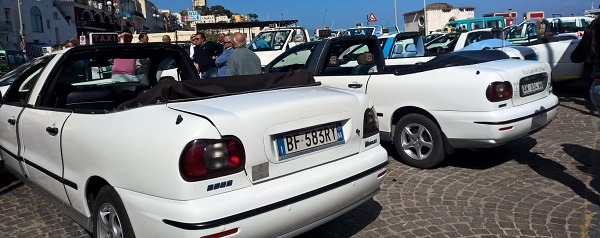
Capri’s unique open top taxis are chic but there is also a funicular train that travels between the Marina Grande and Capri Town. You can take the funicular up to the charming Piazzetta, the heart of Capri town, or the bus to Anacapri, which though still touristy, is more residential and tranquil. The cost of a one-way ticket is €1.80, and can be used for the bus and funicular.
If you don’t want to worry about having enough tickets, there is also a day pass (UNICO Capri costs €8.60) that gives you unlimited bus rides and two trips on the funicular.
What to see in Capri
Head to Anacapri and start your day on the top of the world! At least, it feels that way when you’re up on Monte Solaro, the island’s highest point. A chair lift takes you up for €10 (round-trip). While this may seem costly, btut the splendid views are priceless.
Another gorgeous place to get sweeping views of Capri is Villa San Michele. If you love beautiful gardens, this is a real gem! Built in the early 20th century by Axel Munthe, a Swedish physician, it is home to an enchanting and serene garden that’s billed as one of the top 10 gardens in Italy. With spectacular panoramic views, dreamy pergolas, and surrounded by a variety of flowers and plants, it’s paradise! (Ticket cost: €7).
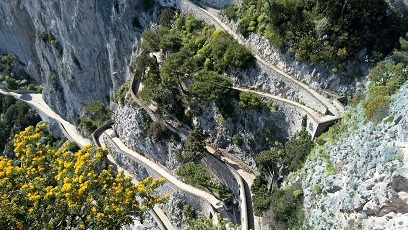
Other areas around to explore around the piazzetta include the Gardens of Augustus. For just €1, this small yet well-kept garden not only offers a splendid view of the Faraglioni, but also of the incredible Via Krupp, which zigzags its way to Marina Piccola.
Places to eat in Capri
Capri is surrounded by restaurants both at the harbour and in town so you will definitely not be short of places to eat.
Visitors should note that Capri is not an ideal beach destination. The island is steep and rocky, with the main settlements high above sea level. There are just a couple of small shingle beaches. On these beaches, and on a few rocky shores, there are bathing establishments where you pay for the use of sunbeds. Apart from swimming pools, most swimming is in deep water off rocky coastlines, so is only advisable for confident swimmers.
Positano
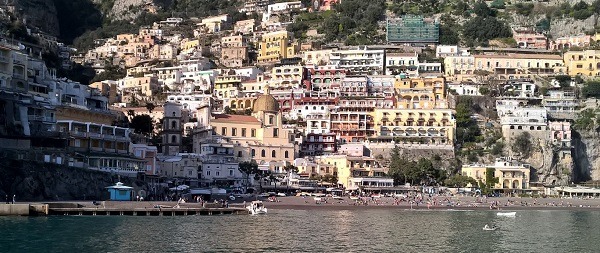
The return ferry from Capri to Amalfi passes through Positano, the most impressive town on the Amalfi Coast. At first look it seems to be lounged on the mountain that overlooks the sea, therefore this city is one of the most photographed of the coast. The sea colour is crystalline and its beaches are crowded of tourists because it has a sandy beach. Among the several beaches of this city it must be mentioned: Marina Grande and Fornillo.
Other attractions include the church of Santa Maria Teresa of the Assumption for its tiled dome, the Saracen towers, the little villages of Nocelle and Montepertuso which are places of an extraordinary beauty.
Positano is also known for its shops. Above all its characteristic production: the leather sandals. Indeed you can go in these little workshops (that can be found in the town alleys) and order sandals made-to-measure.
Positano is where you taste Delizie al limone (soft pastry with a delicious lemon flavoured cream), the torta positanese (cake with almonds) and seafood (according to the maritime vocation of the town the seafood is very good almost everywhere).

